
Headless CMS scales and improves WPWhiteBoard’s content distribution, flexibility, and personalization
Sahil Mahalley
Is your current commerce platform a ball and chain rather than a growth engine? You know you need to deliver world-class experiences to meet customer expectations, but your technology is holding you back.
B2B headless commerce is an architecture that detaches the customer-facing frontend from the backend business logic, connecting them with APIs.
This gives companies the strategic control to build highly customized, fast, and consistent buying experiences across any channel without being limited by a single platform's constraints. It is the modern foundation for agile B2B growth and superior customer engagement.
Your system isn't designed to adapt to economic shifts or sudden market opportunities; it's designed to maintain the status quo. This bottleneck directly affects performance and morale, forcing your teams to work around the technology instead of being empowered by it.
That number represents a massive, quantifiable gap between ambition and reality—a gap that legacy technology simply cannot cross.
The concept of headless commerce is simple. It directly responds to the rigid, all-in-one systems that have constrained B2B businesses for years.
The core idea is to decouple or separate the front end of your e-commerce experience from the back end.
Imagine your customer-facing website—the design, the content, the user interface. That’s the “head.”
Now think about all the complex machinery in the background: your product information, inventory management, customer data, pricing rules, and order processing. That’s the “body”.
In a traditional, monolithic platform, the head and body are fused. They are inseparable.
A headless approach breaks them apart, connecting them with a flexible layer of technology called APIs (Application Programming Interfaces). This one change has profound implications for your business.
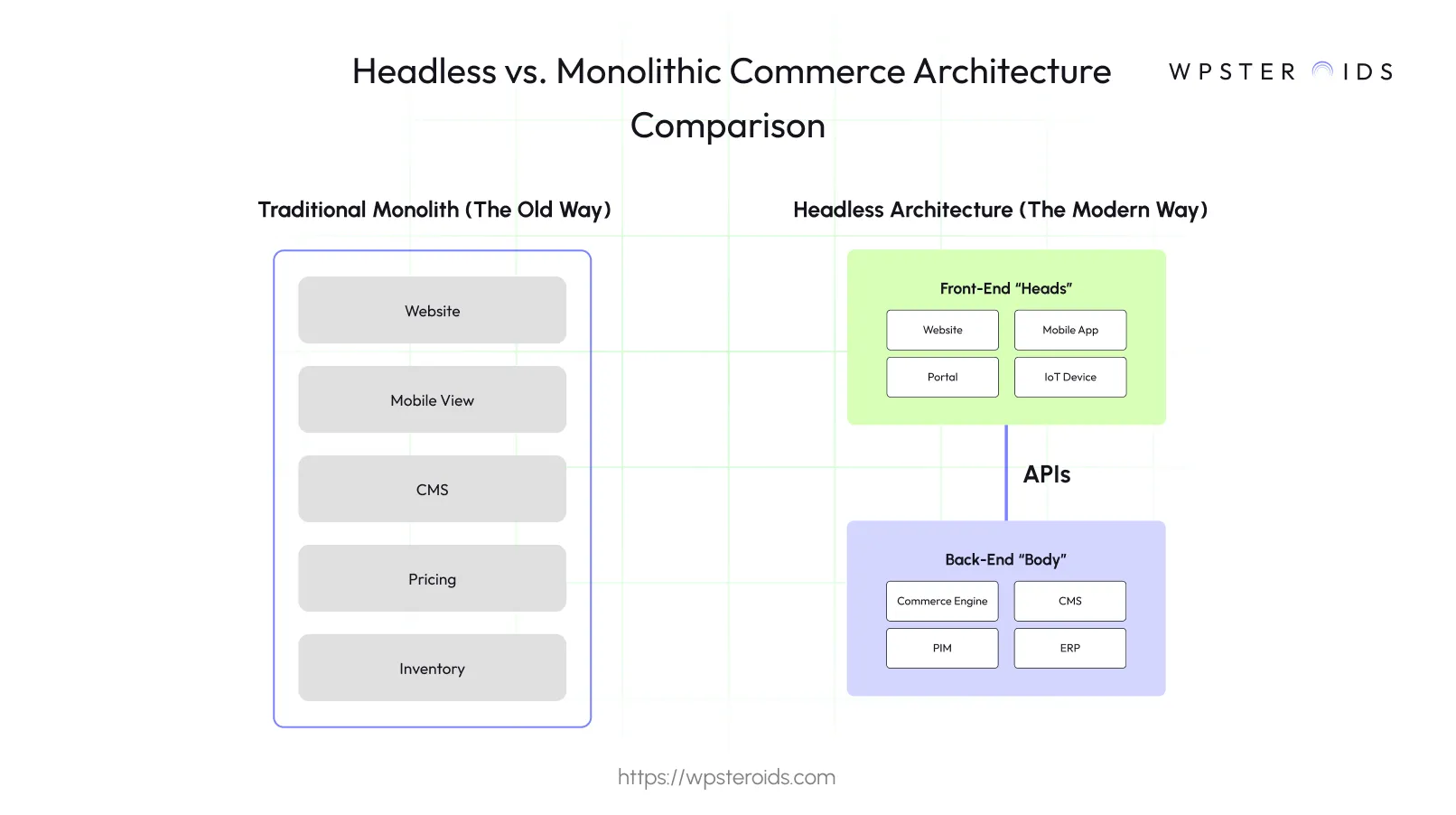
A traditional monolithic platform is like a model home. It comes fully furnished, and all the wiring and plumbing are pre-connected. Everything works right out of the box, which is great initially.
A headless commerce architecture is like building with LEGO. Your back-end systems—the commerce engine, product information manager (PIM), and enterprise resource planning (ERP)—are a box of specialized, pre-built LEGO bricks.
Your front-end is whatever you can imagine building with those bricks.
You are no longer tied to one floor plan. You have the freedom to build anything and, more importantly, to change it anytime you want.
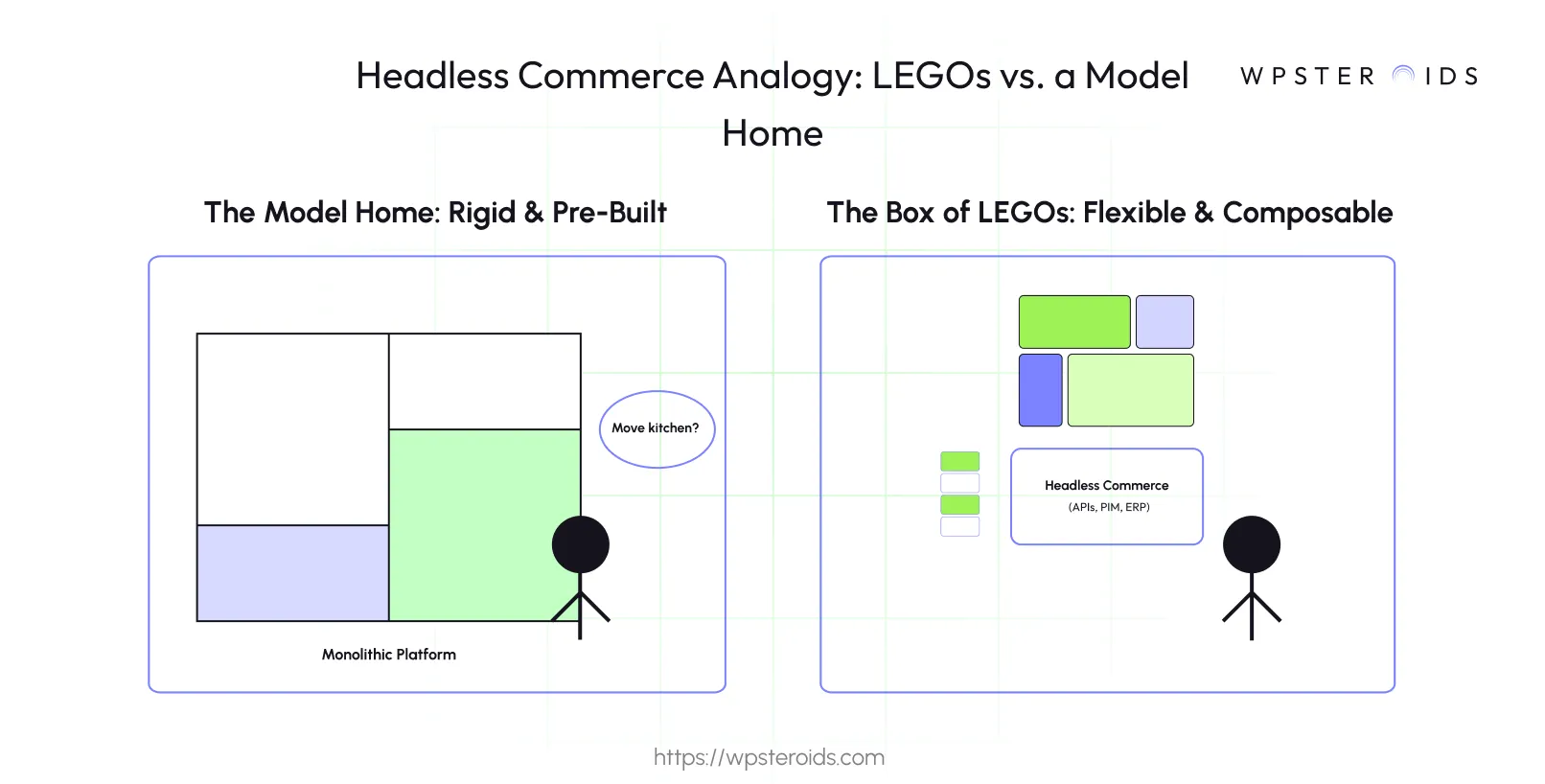
So, what are those LEGO bricks in your new tech stack? A headless architecture typically consists of a few key parts working in harmony:
Now that you understand the core concept, what does this strategic shift do for your business?
For a B2B leader, the benefits of headless commerce unlock new avenues for growth, speed, and competitive advantage. They directly address the frustrations of a rigid system.
A headless approach empowers your teams to innovate at the speed your market demands.
When your marketing team wants to launch a new microsite or create a unique landing page, they don’t have to wait in a long IT queue.
Front-end developers can build and deploy these experiences independently, using the best modern tools while pulling necessary commerce functions from the back-end via APIs. This means you can get to market faster than your competitors.
The modern B2B buyer’s journey is no longer confined to a single website. A headless approach allows you to deliver consistent, connected commerce functionality wherever your customers are.
Your core business logic—product data, pricing rules, inventory—can be seamlessly delivered to:
You build the back-end logic once and then deploy it to any "head" you can imagine.
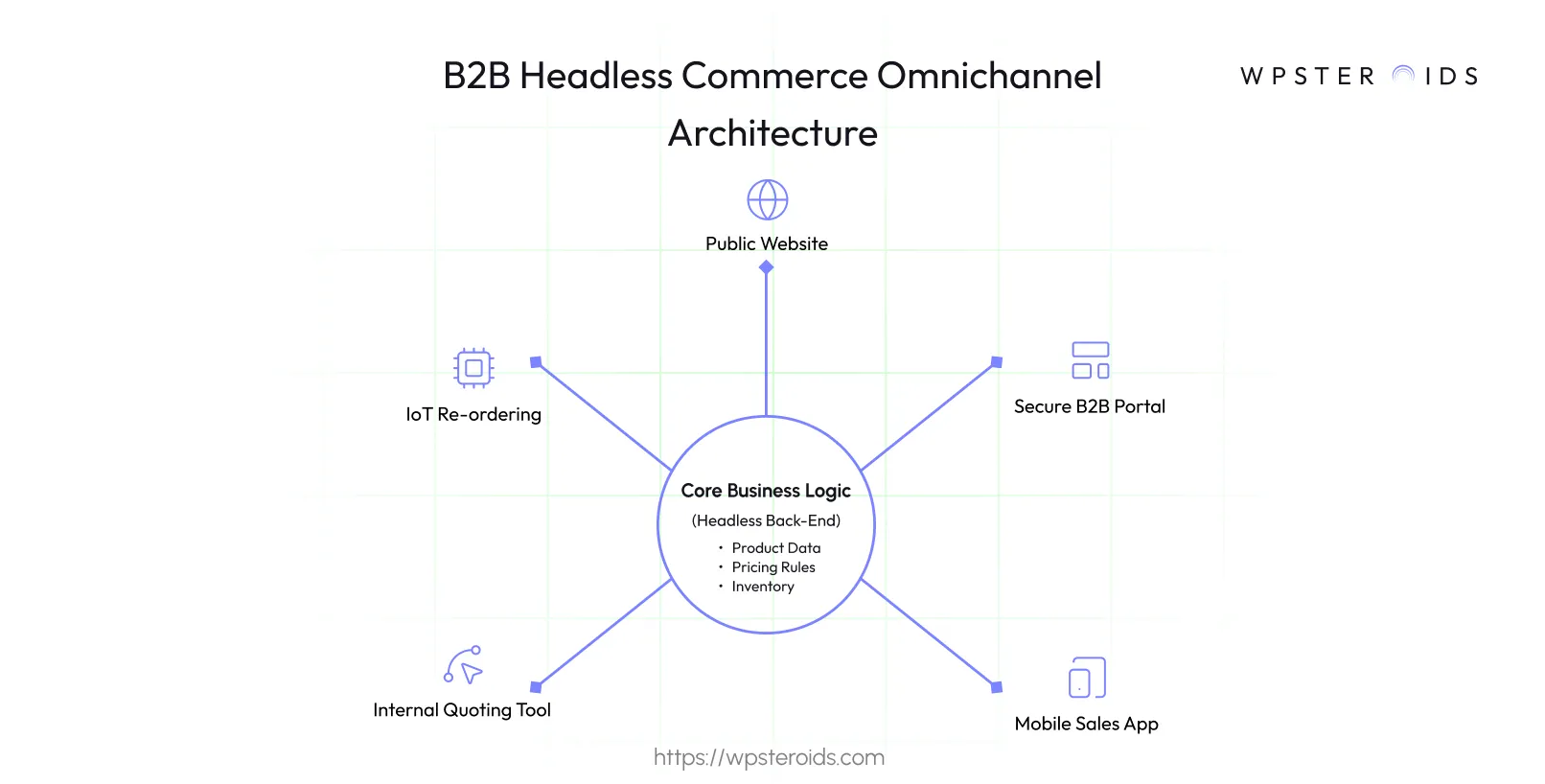
With a headless commerce architecture, you can leverage the latest and best-in-breed technologies for every part of the user experience.
You can integrate a powerful AI-driven search engine, a flexible headless CMS for dynamic content, and a specialized personalization engine.
This allows you to create highly tailored purchasing paths for different buyer groups, industries, or regions.
Ultimately, all these benefits translate into a stronger bottom line. The connection is direct:
The move to a headless architecture is a powerful strategic decision, but it's not a silver bullet. To make an informed choice, it's crucial to be clear-eyed about the potential challenges.
A headless approach requires a different level of investment and technical expertise than an all-in-one platform. You are not buying a pre-built model home; you are assembling a custom-built one.
This often means a higher initial investment in both time and resources. You will need a skilled development team—either in-house or through a partner—that is proficient in modern front-end technologies and API integrations.
The freedom to choose best-in-breed tools introduces a new operational challenge: you now have a multi-vendor tech stack to manage.
Instead of one contract, you may have separate relationships with your commerce platform, CMS, search solution, and personalization engine. This creates additional overhead in vendor management and technical governance.
The APIs are the connective tissue of your headless architecture, but they can also become a bottleneck if not managed properly.
If a single page load requires dozens of excessive or poorly optimized API calls to various services, it can slow the user experience to a crawl. Mitigating this risk requires smart, deliberate architecture.
The very ground beneath B2B commerce is shifting. Today’s B2B buyers bring the expectations they’ve formed as consumers on platforms like Amazon and Netflix into their professional roles.
They demand speed, self-service, rich content, and deep personalisation. The problem isn’t your team or your strategy; it’s that your technology was built for a world that no longer exists.
Your traditional, all-in-one monolith was designed for stability, not speed. It was built for an era where you updated your catalog once a quarter, not once a day.
This rigid architecture is the primary reason you can't move as fast as you want to. Every customization requires a slow, risky, and expensive development cycle.
The true, strategic win is to embrace what industry analysts at Gartner call "business composability."
This is a fundamental shift in thinking. Instead of relying on one massive system, you build an enterprise where business teams can assemble new digital capabilities themselves.
Think back to the LEGO analogy. In a composable enterprise, you provide your teams with a toolbox of pre-approved digital services.
They can then "compose" new customer experiences quickly and independently, without filing a ticket with IT for every change.
Transitioning to a headless B2B commerce architecture is a strategic process. The right path depends on your specific goals, risk tolerance, and current technology.
Before you can chart a new course, you must know your starting position. Start by asking "why?" What specific pains are driving this potential change?
Connect these pains to specific business goals. The objective isn't "go headless," it's "reduce time-to-market for new content by 50%." This ensures your headless B2B commerce strategy is laser-focused on results.
With your goals defined, you face a critical decision. There are two primary paths for implementation:
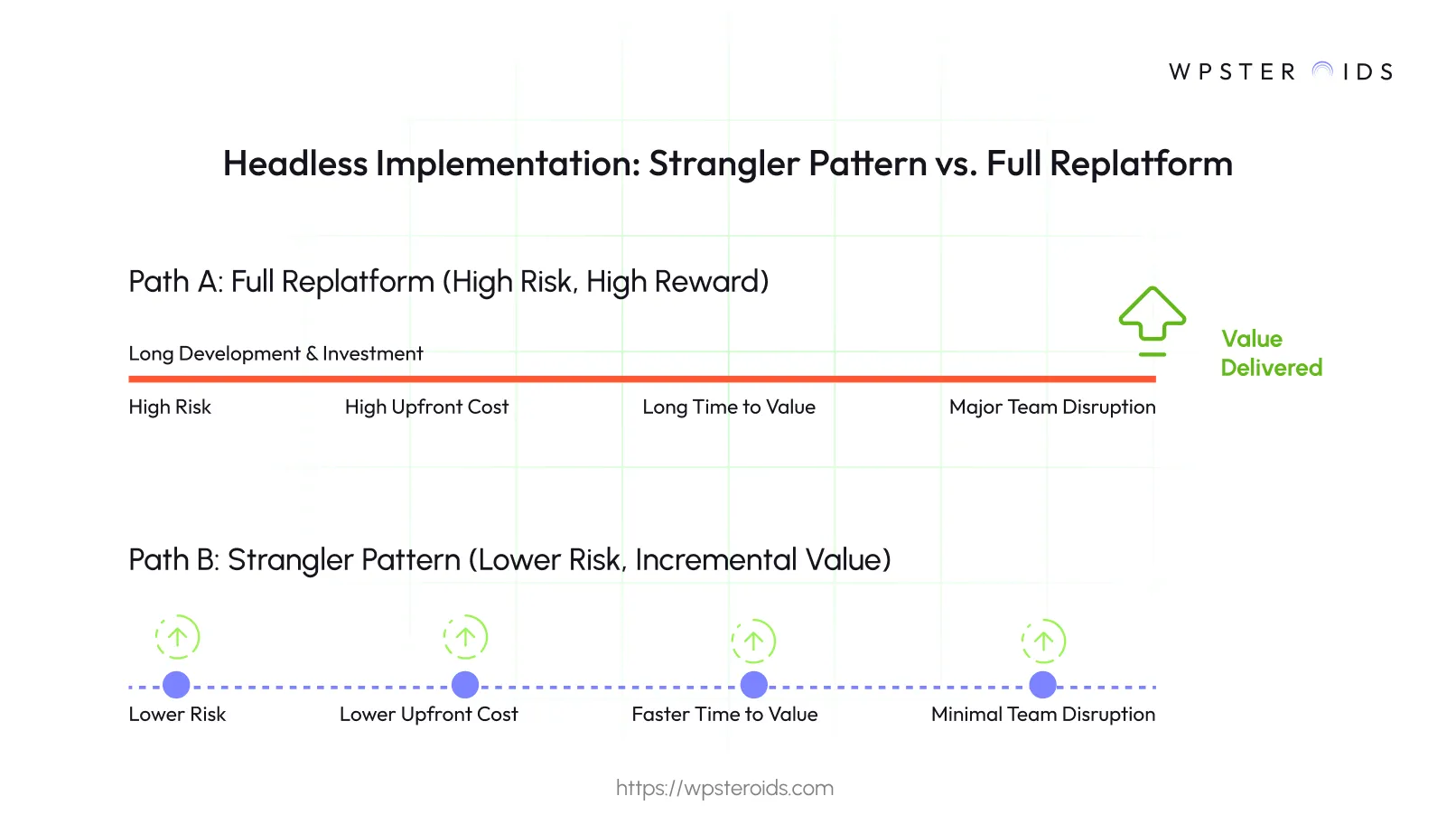
Once you've chosen your path, you can begin selecting your commerce solutions. Your audit in Step 1 will guide your choices.
Your stack will likely include:
The key is to build a toolbox that is flexible, integrated, and designed for agility.
Regardless of your chosen path, always plan for a phased rollout. Think in terms of a Minimum Viable Product (MVP).
What is the smallest piece of this new experience you can launch to deliver value and get feedback?
Launch it, measure the results, gather feedback from real users, and iterate. This agile approach builds momentum and ensures your investment delivers tangible business value every step of the way.
A move to headless commerce fundamentally transforms the core day-to-day operations of your B2B business.
It shifts your teams from fighting with clunky systems to managing a nimble, integrated, and automated ecosystem.
Deciding whether to adopt a headless architecture is a critical strategic choice. To determine the right path, consider these questions:
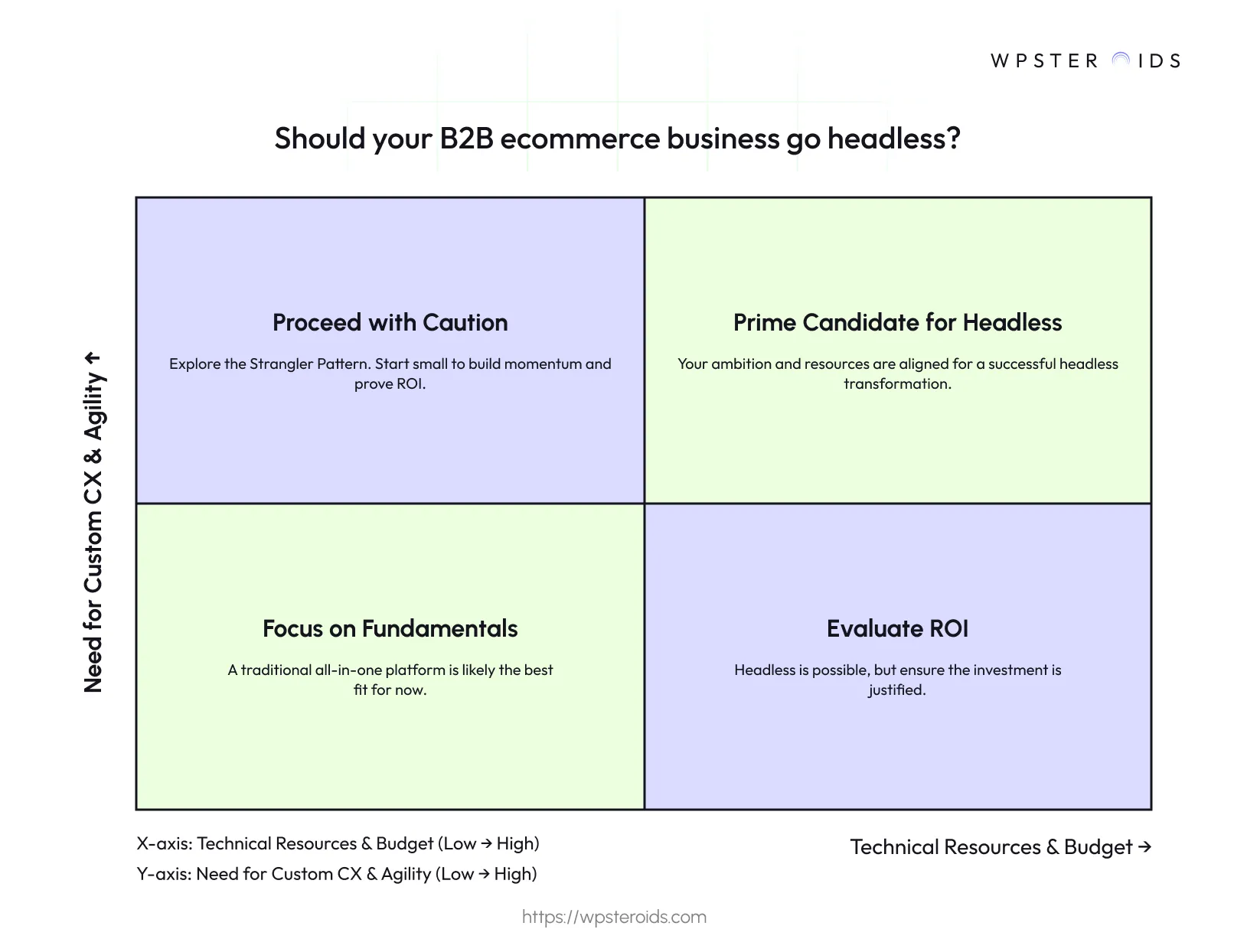
Ultimately, a headless B2B commerce architecture is for the ambitious enterprise that views technology as a competitive advantage.
If your priority is minimizing upfront costs for a straightforward digital presence, a traditional monolith may still be sufficient.
While the headless debate focuses on how a digital experience is built, it's crucial not to lose sight of what is being built.
Regardless of your front-end architecture, the core commerce engine must be purpose-built to handle the unique complexities of business-to-business transactions. B2B is not B2C.
Trying to adapt a B2C-focused platform for B2B use is a common and costly mistake.
Adopting a headless architecture comes down to a single question: Do you view your technology as a necessary cost center or a primary driver of competitive advantage?
A headless, composable architecture is for the ambitious enterprise that needs to move faster, create superior customer experiences, and future-proof its operations. It is how you finally break free from the constraints of your old system.
It is how you empower your teams to build the future, transforming your technology from a ball and chain into your most powerful engine for growth.
